Browser Profile Settings
Browser profile settings are a set of parameters that are configured when a profile is created and on the basis of which websites and services will receive information about your system and generate a fingerprint.
The settings generated by default are suitable for the vast majority of users. All generated fingerprint parameters are selected for maximum compatibility, and if some parameters (e.g., the User Agent) are manually changed, profile integrity may be compromised. Please read the documentation thoroughly and be careful and exercise common sense if you decide to change your browser profile settings manually.
Each Chromium build has its own peculiarities, and Octo Browser takes those into account, generating fingerprints with maximum compatibility. If you want to transfer an account from another browser, you need to do the following:
- When generating a fingerprint, make sure to use the same OS as the one you are transferring the account from (e.g., use the Win fingerprint for Windows).
- Set Hardware Settings as close as possible to the system you are transferring from (CPU/RAM/GPU).
- You can set the screen resolution and other system features to match the one from which you are transferring the account.
- We recommend against changing the default user agent, as this may compromise profile fingerprint integrity. Octo Browser generates the user agent exactly as it should be.
It is highly recommended to use the Chrome version provided by default. The Octium version in use is based on the latest Chromium version.
General Settings
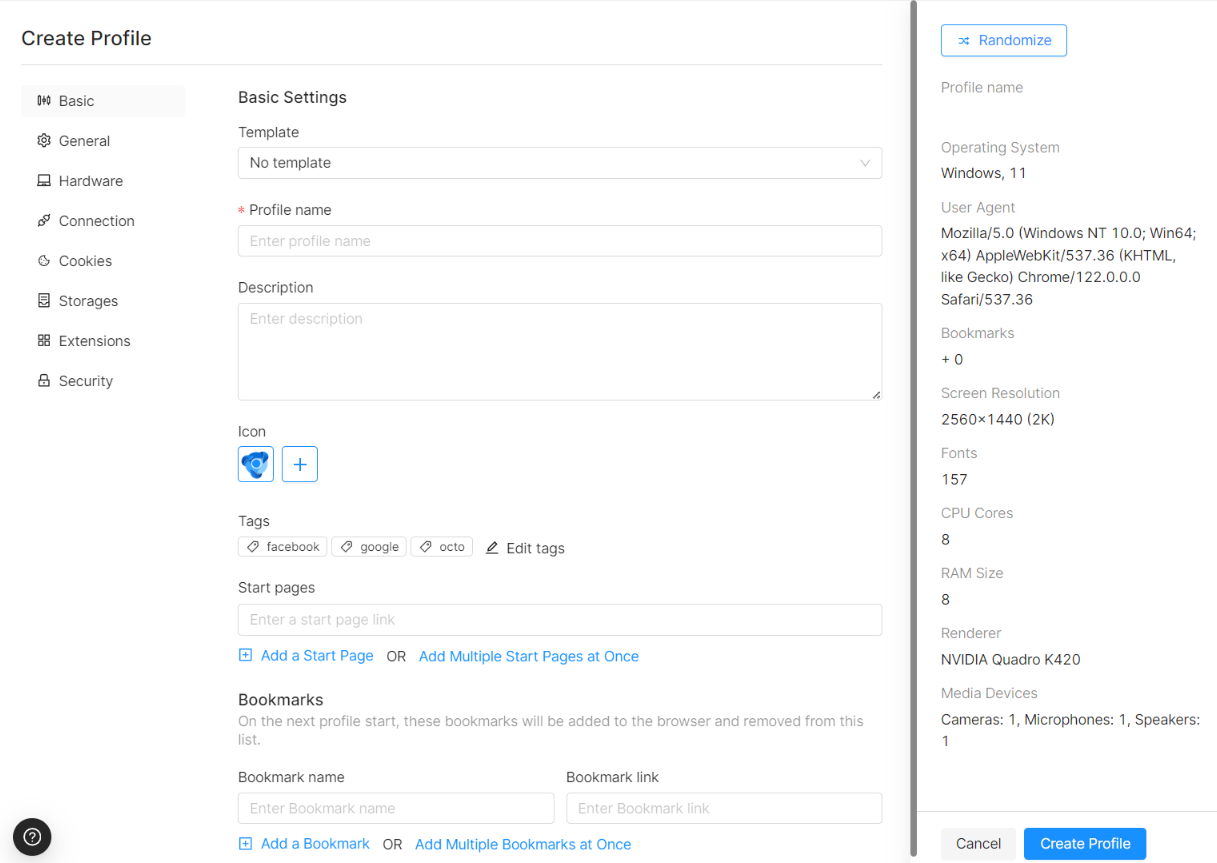
Profile Icon allows you to choose from pre-installed icons or upload a new one and apply it to the profile. The icon will be displayed on the profile list to the left of the profile name for ease of navigation and search in the list. You can use up to 20 icons.
Profile Name is a required field. Here you can set a name for the profile that will be displayed in the list of profiles.
Template allows you to select a template for the profile or choose the "No template" option. If you choose a template, its settings will be used to set the profile settings. If a template is set to "Active" in the Templates tab, then by default when a new profile is created, the active template settings will be applied to the new profile, and the active template will be indicated in the Template field, where you can also disable it or select a different one.
Description is an additional field where you can store the necessary information about the profile for your convenience.
Proxy assigns a proxy for the browser profile in use. The default value ("Set a proxy") indicates that the profile will be created without a proxy, and it will use your real IP address or the IP address of your VPN if a VPN is enabled on your operating system. You can add a proxy from the Proxy Manager list, or add a temporary proxy. HTTP, HTTPS, SOCKS5, SSH proxies are supported. Please note that if you are using a VPN and a proxy together, the response time and speed may decrease, and this might negatively affect the usability.
To quickly fill in proxy data, use the template ip:port:login:password (or you can specify the protocol in the beginning, e.g. protocol://login:password:ip:port). Delimiters are also supported ( ; , @ , space) in any order.
Make sure that proxies are formatted correctly. Next, using hotkeys such as CTRL+V, paste the proxy data in the field labeled "Enter IP or domain". SOCKS5, HTTPS, HTTP, and SSH protocols are supported.
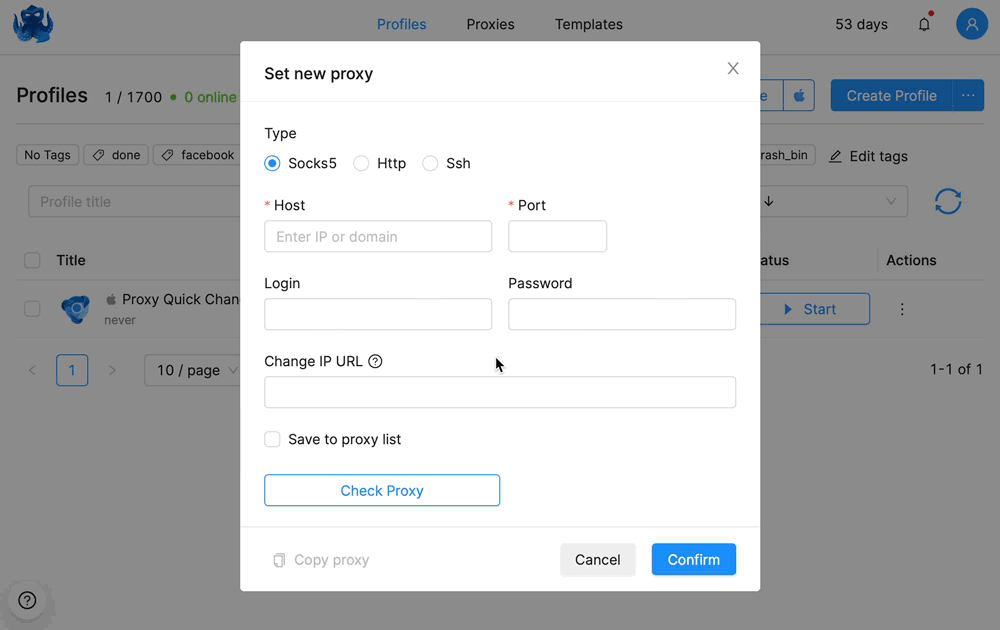
Tags are labels for filtering, similar to folders, allowing you to conveniently filter the desired profiles in the list. Each profile can have one tag, several tags, or none at all. There is no limit on the number of tags in any of the subscriptions.
Start pages and bookmarks
Start pages is a field where you can specify the start pages of the profile if necessary. Each time you start the profile, the start page(s) will open in the first tab along with the previously opened tabs.
You can add a maximum of 20 start pages.
Copy and paste the list of desired URLs using either line break or space as delimiters. The list of start pages will expand.
Acceptable formats for adding start pages:
https://sitename.com
sitename.com
Bookmarks is a field for adding and saving favorite links to web resources into the "Bookmarks" menu of the profile. You can also assign a name to each link.
Copy and paste the list of desired URLs using either line break or space as delimiters. The list of bookmarks will expand.
Acceptable formats for adding bookmarks:
bookmark name::https://sitename.com
bookmark name::sitename.com
https://sitename.com
sitename.com
If no bookmark name is specified, the names for bookmarks will be used from the link domain name (google.com, ebay.com, etc.).
You can add up to 100 links at a time.
The next time you start the profile, the bookmarks will be added to the browser and disappear from this list.
Storage Settings
Storage settings indicate which data will be saved when the profile is stopped.

Cookies enables cookie and session data saving.
Passwords enables saving passwords.
Extensions enables saving profile extensions.
Local Storage enables saving Local Storage and IndexedDB data. All services that use Local Storage to keep data will be logged out when the profile is reopened if Local Storage is disabled.
History enables saving browser history data.
Bookmarks enables saving browser bookmarks.
Service Workers: some sites store here their webpage cache for offline work or other information (for example, Telegram stores part of its authorization data using Service Workers). If you do not require this function, we recommend against enabling it, as the size of the profile will increase significantly.
Additional Settings

DNS is the IP address of the DNS server. By default (if the value is empty), the proxy or VPN DNS server will be used. When using an SSH proxy, custom profile DNS settings are not applied.
Browser startup command-line switches allow you to control browser behavior directly from Octo (e.g., you can block images, disable notifications, and change other settings before launching a profile).
This feature is designed for advanced users who know exactly what parameters they need. If you are not sure if these settings are necessary, we recommend leaving this field blank.
Port scan protection is a built-in mechanism designed to prevent attempts to identify open network services. Web resources will not be able to determine which ports are open on your local network. You cannot disable port scanning protection, as this is a key setting for the fingerprint.
Fingerprint
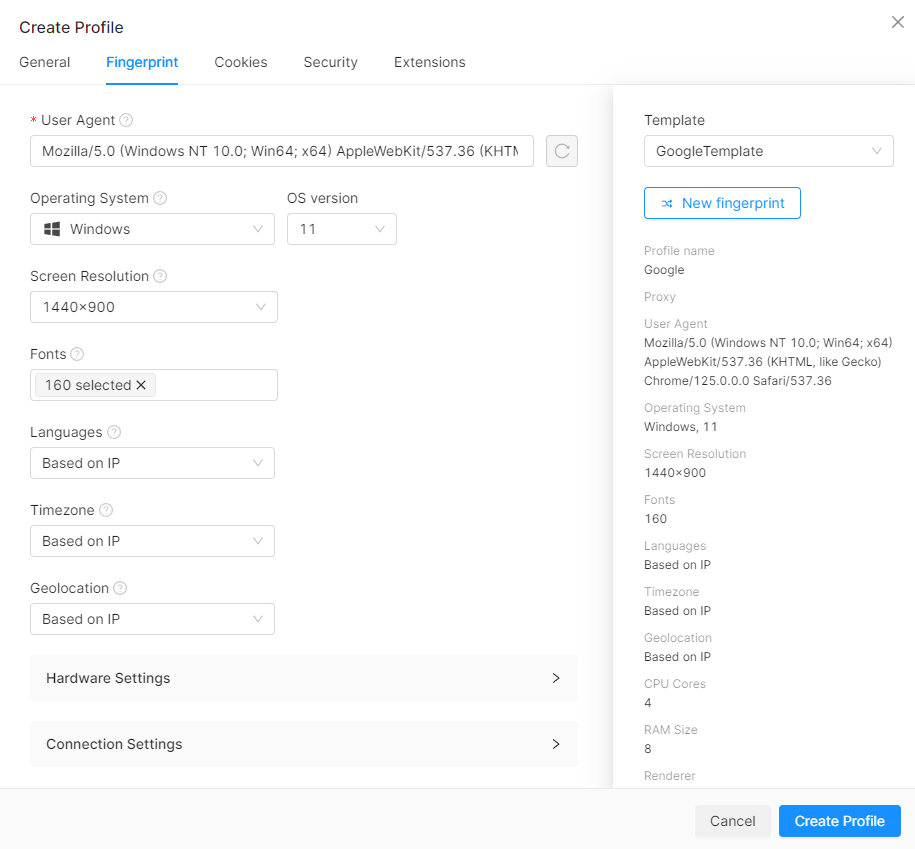
User Agent is the client application identifier generated based on the profile OS. For Android profiles, the user agent for mobile devices is used. The user agent contains information about the spoofed device, operating system, and browser version. For best compatibility, it is recommended to generate the user agent by using the "New fingerprint" button. You can change the user agent manually, but this may negatively affect the integrity of the generated fingerprint. We recommend against doing it.
Since July 2022 only the major version is displayed in the Chrome user-agent (like *.0.0.0).
Users make all changes to the user agent at their own peril and risk. If the user agent has been changed manually by the user, a corresponding notification will be displayed in the profile settings. If necessary, you can generate the actual user agent used in Octo Browser by clicking on the update button next to it.

Operating system selects the profile operating system. By default, the user device OS will be used for a new profile. At the same time, you can change the profile OS when creating it (currently, you can choose between Windows, macOS Intel, macOS ARM, and Android). We recommend using the OS of your device as the profile OS. For mobile fingerprints, you can use a device with any operating system. The resulting profile fingerprint will be generated based on the selected OS version. Once a profile has been created and saved, its OS cannot be changed.
OS Version selects the version of the operating system.
Screen resolution allows you to select one of the screen resolutions most commonly used by real users. The screen resolution defines a fixed area that a profile with the corresponding values will use when opened; the maximum available resolution is limited by your real system resolution. The screen resolution can also be changed later on. In most cases, resolution changes do not affect the integrity of the fingerprint. Services can perceive changes of the resolution as connecting and using a display with a different resolution. Choosing screen resolutions is not possible for Android profiles.
Fonts spoofs a set of fonts installed in the system. A set of fonts is generated based on the chosen OS. Some websites may check if certain fonts are installed in the OS. We recommend that you do not change this setting without a strong reason. If you have accidentally changed the font set, you can use the Undo Changes feature before saving the profile. Choosing fonts is not possible for Android profiles.

Device type lets you select the spoofed mobile device type (you can choose phone or tablet). Depending on the selected device type, the working area size of the launched profile will change. This setting is only available for Android profiles.
Device model indicates the model of the emulated mobile device and its corresponding parameters based on real user fingerprints. This setting is only available for Android profiles.
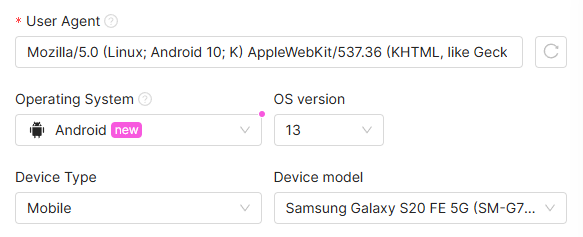
Languages spoofs browser profile languages in use. The browser interface language does not affect the spoofed languages in any way, and is set according to the system language. By default, when a profile is started, the external IP address is checked and the languages corresponding to your IP are set. The ultimate value of the external IP depends on the type of connection: direct connection, a proxy connection, or a VPN with a direct connection, and in most cases works correctly. The discrepancy between the languages and the geo of your proxy can only be in the difference in the geo IP bases. If necessary, you can change this setting manually. It is not recommended to turn this setting off (by setting the real one).
Timezone spoofs the time zone used in the browser profile. Similar to Languages, the default time zone corresponds to the external IP address geolocation and is set automatically each time. If necessary, you can change this setting manually. We recommend against turning this setting off (by setting the real one).
Geolocation spoofs the geolocation used in the browser profile. Similar to Languages and Timezone, the default settings correspond to the external IP address geolocation. The latitude and longitude are provided randomly in the range of an automatically defined geolocation. When you visit websites that attempt to learn your location using Geolocation API, you will see a notification asking you to grant access to this data. Until you grant it, sites will not receive location data using Geolocation API, and all information about your location will be derived only from the IP database the site uses. The data that websites receive using Geolocation API corresponds to the IP address of your proxy (the "Based on IP" setting). If necessary, you can change this setting manually. Choosing a location that corresponds to real-world objects is recommended. We recommend against turning this setting off (by setting the real one).
When setting Geolocation manually, you need to provide the Latitude, Longitude, and Accuracy parameters. Accuracy represents the error margin in determining the coordinates of latitude and longitude (in meters). By default, you can set this value within the 1-999 range, and then tweak it for a specific task or service behavior.
WebRTC selects the spoofed WebRTC value based either on the external IP address of the proxy or the real one, or it can be disabled altogether. By default, the Based on IP option automatically replaces the IP address value with the external IP address of the proxy. If the "Disable UDP" option is enabled, all unproxied UDP traffic will be disabled. This is similar to disabling WebRTC; however, instead of IP spoofing, TCP-based traffic will continue to flow, while UDP-based traffic, on which all real IP address leakages depend, will be completely disabled.
Hardware Settings

CPU cores shows the number of emulated processor cores for the selected profile.
RAM Size shows the amount of emulated RAM for the selected profile.
Renderer shows the model of the emulated GPU and its corresponding parameters based on real user fingerprints.
Hardware Noise covers automatic software deviations from system values creating a unique fingerprint of certain capabilities of a browser profile.
- WebGL enables hardware noise for WebGL.
- Canvas enables hardware noise for Canvas.
- Audio enables audio hardware noise.
- Client Rects spoofs the size of page elements (page elements differ on different devices, and this indicator can be used to identify devices). Sometimes this spoof may incorrectly display page elements on some sites. If you encounter such issues, you can try disabling this spoof parameter.
If you need to hide some parameters of your browser fingerprint and replace their values with unique values, you can enable hardware noise. If you want to blend in with the crowd, turn off the hardware noise. We recommend that you do not change the hardware noise settings unless absolutely necessary, as some services may react to the presence of hardware noise negatively.
Media devices emulates connected multimedia devices that will be seen by websites or services when working with this profile. In emulation mode, working with these devices is not possible. This means that access to your camera or microphone will not be physically granted, but the declared set of characteristics will be provided. For example, Facebook will be able to detect that camera support is declared in a profile, but will not be able to interact with it when working with such a profile. If you have multiple cameras or microphones, set the number of cameras and microphones identical to their physical number on the device to ensure that you can choose between them.
Hardware Settings only apply to Windows and macOS profiles and are not available for Android profiles.
Cookies
Valid cookies in JSON and Netscape formats are supported. To add them, you can drag and drop a file with the necessary data into the corresponding field, or click on that field and paste copied cookies.
If a profile has been deleted after importing cookie files, the cookie data will not be saved and will not be available if the profile is restored from the Trash later. Launch the profile at least once after importing cookies to save them correctly. Since the cookies were imported from an external source (a file), they can be re-imported into a restored or new profile if necessary.
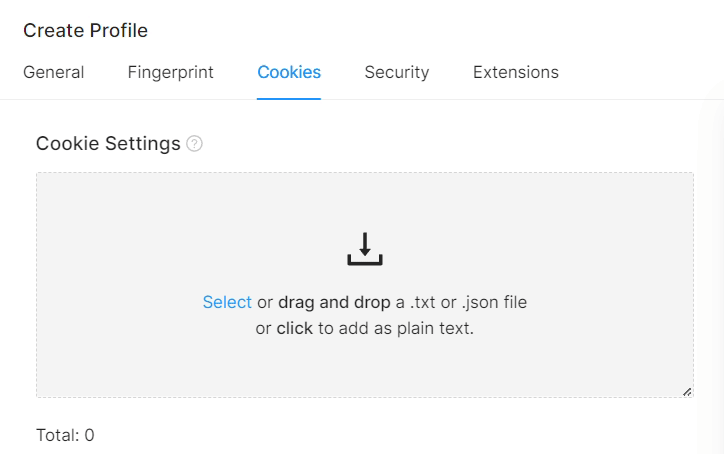
Security
Here you can set the profile password.
A profile password is an additional security measure available to our users. This feature allows users to generate keys for encrypting individual profiles. The password will protect the profile data on the server with end-to-end encryption and will be requested when the profile is launched.
IMPORTANT!
Octo Browser does not store passwords. If you forget your password, we will not be able to help you regain access to your password-protected profiles.
Password-protected profiles: details and features
- Password requirements: minimum 4 characters, maximum 255 characters.
- When you set a profile password, all previous profile versions will be deleted.
- The number of attempts to enter the password is not limited.
- Mass operations with password-protected profiles are not supported. E.g., mass launching profiles using keyboard shortcuts will skip password-protected profiles.
- You can send a password-protected profile to the Trash. When you restore a password-protected profile from the Trash, it is restored with the password.
If you have password-protected a profile, you will not be able to:
- Export this profile.
- Transfer this profile to another Octo Browser account.
- Launch the Cookie Robot.
Extensions
This section allows you to select extensions from the list of extensions already added to profiles. In order for extensions to be displayed in this section, you need to enable saving extensions in the profile, start the profile, and install the necessary extensions into the profile. Adding extensions is only possible to Windows and macOS profiles and is not available for Android profiles.

After extensions have been installed, they will be displayed in the list for all team members and devices. If you have turned on the corresponding toggle in Storages (Extensions), you can select them from the list (without having to install them again) and assign them to other profiles.

New Fingerprint
New fingerprint changes the fingerprint of the profile being edited. The following profile parameters from the "Fingerprint" section are changed:
- OS version (it is changed only when creating a new profile, the OS version is not changed when editing the parameters of an already existing profile);
- Screen resolution;
- Fonts;
- The number of CPU cores;
- RAM size;
- Renderer.